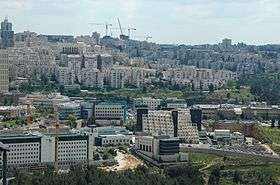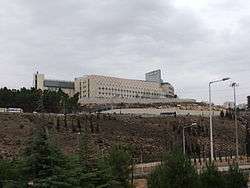Har Hotzvim
| Mount Hotzvim | |
|---|---|
| הַר חוצבים, Har Hotzvim | |
 Har Hotzvim, view from Ramat Shlomo | |
| Highest point | |
| Elevation | 700 m (2,300 ft) |
| Coordinates | 31°48′9.1″N 35°12′34.69″E / 31.802528°N 35.2096361°ECoordinates: 31°48′9.1″N 35°12′34.69″E / 31.802528°N 35.2096361°E |
| Geography | |
 Mount Hotzvim Har Hotzvim in Jerusalem | |
| Location | Jerusalem |
| Parent range | Judean |
Har Hotzvim (Hebrew: הר חוצבים, lit. Stonecutter's Mountain), also Campus of Science-Rich Industries (Hebrew: קריית תעשיות עתירות מדע, Kiryat Ta'asiyot Atirot Mada) is a high-tech industrial park located in northwest Jerusalem. It is the city's main zone for science-based and technology companies, among them Intel, Teva, NDS (now Cisco), RAD Data, Mobileye, Ophir Optronics, Sandvine, Radware, IDT Global Israel, Medtronic, Johnson and Johnson and more.[1] In addition to large companies, the park also hosts about 100 small and medium-sized high-tech companies, as well as a technological incubator.[2] In 2011, Har Hotzvim provided employment for 10,000 people.[3]
History


The park was founded in the early 1970s by the Jerusalem Economic Corporation, in order to facilitate the development of a high tech industry in Jerusalem.[4] At the time the location was at the edge of the built up area of the city, but over the years several major roads were built and accessibility to the site was improved; including: the Begin Expressway to the west of the park and Route 9 north of the park. One of the first tenants in the park was Luz Industries[5] an early pioneer of Solar thermal energy, which in the 1980s built the world's largest solar energy generating facility SEGS in the Mojave Desert.[6]
The first major international corporation to establish a base at Har Hotzvim was Intel, which opened its Fab 8 semiconductor manufacturing plant in 1985.[7]
In the early 1990s, as Jerusalem was awarded the status of a preferred development zone for the high-tech industry, an expansion plan was initiated by the Jerusalem Development Authority. The expansion took place in three stage (known as Har Hotzvim stage b, c and d) and by the mid 2000s most of the available plots have been developed.
In 2005, Teva Pharmaceutical Industries opened a new, state-of-the-art pharmaceutical manufacturing plant in Har Hotzvim, at a cost of US$80 million. It initially produced about 4 billion tablets a year, rising to 8 billion a year when the second phase of building was completed.[8]
In 2008 Intel closed its aging Fab 8 chip plant and started converting the facility to a die preparation plant. The plant was inaugurated in November 2009; the company planned to operate it on Saturdays in accordance with its business needs, requiring continuous operation of the production line.[9] This angered the Haredi Jewish community living in nearby religious neighborhoods, who strictly observe the Sabbath laws. For several weeks they gathered every Saturday outside the building; some threw rocks at the building and the police. Eventually representatives of the Haredi community reached an agreement with Intel to keep the plant open on Saturdays, but allow only non-Jews to work.[10]
In July 2011 Haredi United Torah Judaism party in the Jerusalem city council proposed to clear the area for new residential development for their community, an offer that was firmly rejected by Jerusalem's mayor Nir Barkat[11]
Tenants
|
|
|
See also
References
- ↑ Official website (English)
- ↑ Biojerusalem
- ↑ http://www.haaretz.com/hasen/spages/1035935.html
- ↑ Jerusalem Economic Corporation - Company's Profile
- ↑ New Headquarters for Luz Industries, Jerusalem
- ↑ Solar Energy in Israel
- ↑ Intel Jerusalem profile
- ↑ Gavison, Yoram (2005-09-13). "Teva unveils new plant in Jerusalem: Teva invests 80 million dollars in the plant". Haaretz.
- ↑ "Intel to open Jerusalem plant next week". Reuters. Nov 8, 2009.
- ↑ "Intel to remain open on Sabbath in Jerusalem: Protests by ultra-Orthodox Jews turn violent at chipmaker's facility". Associated Press. 2009-11-15.
- ↑ Azulai, Yuval (14 July 2011). "Haredim want Jerusalem high-tech park for housing". Globes.
External links
| Wikimedia Commons has media related to Har Hotzvim. |
